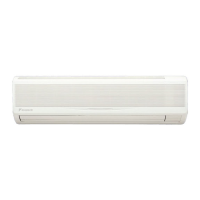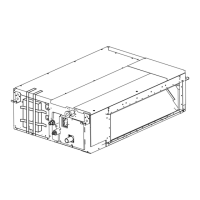Do you have a question about the Daikin VRV FXAQ20ARVE6 and is the answer not in the manual?
Information about the fluorinated greenhouse gases used in the air conditioner.
Instructions on how to adjust the louvers for optimal air direction.
Important safety warnings for qualified personnel performing maintenance on the unit.
Safety precautions for cleaning and maintenance to avoid damage or injury.
Step-by-step guide for cleaning the air filter of the indoor unit.
Instructions for cleaning the external parts and air outlet of the unit.
Procedure for removing and cleaning the front panel of the indoor unit.
Guidelines for the proper disposal of the air conditioning product and its components.
Critical safety warnings regarding installation, refrigerant, and parts usage.
Precautions for safe electrical work, earthing, circuit breakers, and wiring.
Cautions regarding installation locations, drain piping, and interference prevention.
Key precautions and recommendations before commencing the installation process.
List of accessories provided with the air conditioning unit for installation.
Information on optional accessories available for the air conditioner.
Essential checks to be performed after the installation is completed.
Items to verify and confirm at the time of unit delivery.
Key points to explain to the customer regarding the operation of the unit.
Important notes and instructions for the installer regarding customer operation.
Conditions and requirements for selecting an appropriate installation site for the unit.
Precautions regarding installation near electronic devices and fluorescent lights.
Safety cautions to follow when installing the indoor unit.
Procedure for creating the opening for refrigerant and drain pipes.
Steps to remove and attach the installation panel to the wall.
Instructions for removing the front panel, service cover, and front grille.
How to position the refrigerant piping and drain hose for passage.
Steps to securely hook the indoor unit onto the prepared installation panel.
Guide for routing power supply, transmission, earth, and remote controller wiring.
Reference to the outdoor unit installation manual for refrigerant piping details.
Importance and method of insulating gas and liquid refrigerant piping to prevent leaks.
Ensuring the refrigerant type is R410A for proper unit operation.
Precautions for using R410A refrigerant, including tools, flare connections, and contamination.
Guidelines for making flare connections and proper tightening torques for refrigerant pipes.
Precautions and methods for brazing refrigerant piping, including flux use and nitrogen purging.
Steps and considerations for installing the drain piping to ensure proper drainage.
Guidance on using and insulating drain extension hoses for indoor sections.
Cautions regarding drain piping connections to prevent ammonia ingress and blockages.
General guidelines and local code requirements for electric wiring.
Technical specifications for power supply, MCA, MFA, kW, and FLA for different models.
Specifications for field supplied fuses, power supply wiring, and remote controller wiring.
Procedure for connecting power supply and earth wiring to the terminal block.
Procedure for connecting transmission and remote controller wiring to the terminal block.
Guidelines and torque specifications for tightening terminal screws.
Precautions for connecting power supply wiring and preventing system damage.
Illustrations and explanations of common wiring configurations for the system.
Wiring for group control and systems using multiple remote controllers.
Wiring configurations when a BS unit is included in the system.
Important precautions for transmission wiring, power supply, and earthing.
Configuration for using two remote controllers with one indoor unit.
Wiring and operation for forced off and on/off functions via external input.
Information on designating group numbers for centralized control operation.
Overview of field settings using mode, first code, and second code numbers.
Adjusting the air filter cleaning notification based on room contamination.
Configuring airflow rate settings like standard, little increase, and increase.
Identifying potential issues during test run using remote controller display codes.
Items to check after the test run is completed, referencing delivery checks.
| Model | FXAQ20ARVE6 |
|---|---|
| Refrigerant | R410A |
| Weight | 45 kg |
| Power Supply | 220-240V |
| Power Source | Electric |












